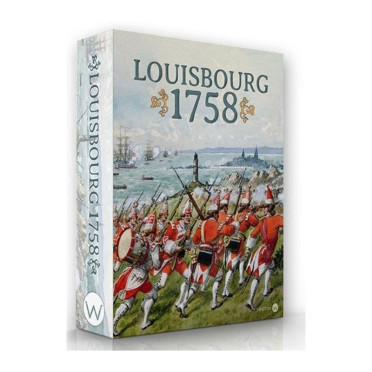Louisbourg 1758
WPUB089
- English
- From 14 years old
- 1 to 2h
- 2 player(s)
he capture of Louisbourg in 1758 was one of the most important confrontations of the Seven Years' War. Louisbourg protected the entrance to New France from the St. Lawrence River. Far inferior in numbers and firepower, Louisbourg eventually fell to the British, but the French fortress held out long enough to prevent a British campaign in 1758 against Quebec and the interior of New France.
The British player's objective is to occupy the fortress of Louisbourg with his army, or to occupy the port of Louisbourg with his ships. The French objective is to prevent the British from achieving their objectives by the end of the game.
The game consists of 16 turns. Each turn comprises an operational phase, a bombardment phase and a player action phase for each side. During the player action phase, a player has one action to use for the turn. Actions are used to move army units, carry out landings with ships and army units, conduct raids or move ships in and out of sea zones.
There are two maritime locations on the game board, the port of Louisbourg and Gabarus Bay. These are the only places where ships are allowed. Land units are not allowed to occupy sea locations, but may cross them to adjacent land locations if carried by ships. British ships start in Gabarus Bay.
Game units represent army units and ships during the campaign. Each unit is represented on a wooden block printed with information about the unit. French units are represented by blue wooden blocks and British units by red wooden blocks.
Operational cards can be used by any player. There are a limited number of cards available, and this is a shared deck used by both players. The cards have a flag, either British or French, showing which side is affected by it. The only card they can play is the one that has their flag on it and is played face-up. Players can only play cards that affect them, not their opponent. Cards with an opponent's flag in a player's hand can only be discarded.
On odd-numbered turns during the operations phase, players draw a card from the operations deck if their cards in hand are less than three. They may play or discard (without showing their opponent) a card when they are active for the turn, or when the card indicates. They may not play a card when their opponent is active. If a card is played, it is played face-up and is only effective for the turn in which it is played.
- 1 Game Board mounted on Rigid Cardboard
- 2 Rule Books
- 20 Blue Wooden Blocks
- 30 Red Wooden Blocks
- 1 Set of Cards
- 8 Dice
- 1 Customized Storage Tray
| Theme(s) | War | |
| Language(s) | English | |
| Mechanism(s) | Wargame | |
| Editor | Worthington Games |
Soyez le premier à commenter ce jeu
Vous devez être identifié pour soumettre des avis.
Copyright © 2024 www.philibertnet.com Legals - Privacy Policy - Cookie Policy - Sitemap





